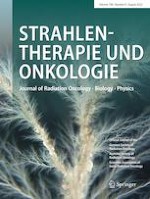Erschienen in:

21.01.2022 | Original Article
Radiomics-based prognosis classification for high-risk prostate cancer treated with radiotherapy
verfasst von:
Ciro Franzese, MD, Luca Cozzi, PhD, Marco Badalamenti, MD, Davide Baldaccini, MD, Giuseppe D’Agostino, MD, Antonella Fogliata, MSc, Pierina Navarria, MD, Davide Franceschini, MD, Tiziana Comito, MD, Elena Clerici, MD, Giacomo Reggiori, MSc, Stefano Tomatis, MSc, Marta Scorsetti, MD
Erschienen in:
Strahlentherapie und Onkologie
|
Ausgabe 8/2022
Einloggen, um Zugang zu erhalten
Abstract
Objective
The present study aimed to investigate if CT-based radiomics features could correlate to the risk of metastatic progression in high-risk prostate cancer patients treated with radical RT and long-term androgen deprivation therapy (ADT).
Materials and methods
A total of 157 patients were investigated and radiomics features extracted from the contrast-free treatment planning CT series. Three volumes were segmented: the prostate gland only (CTV_p), the prostate gland with seminal vesicles (CTV_psv), and the seminal vesicles only (CTV_sv). The patients were split into two subgroups of 100 and 57 patients for training and validation. Five clinical and 62 radiomics features were included in the analysis. Considering metastases-free survival (MFS) as an endpoint, the predictive model was used to identify the subgroups with favorable or unfavorable prognoses (separated by a threshold selected according to the Youden method). Pure clinical, pure radiomic, and combined predictive models were investigated.
Results
With a median follow-up of 30.7 months, the MFS at 1 and 3 years was 97.2% ± 1.5 and 92.1% ± 2.0, respectively. Univariate analysis identified seven potential predictors for MFS in the CTV_p group, 11 in the CTV_psv group, and 9 in the CTV_sv group. After elastic net reduction, these were 4 predictors for MFS in the CTV_p group (positive lymph nodes, Gleason score, H_Skewness, and NGLDM_Contrast), 5 in the CTV_psv group (positive lymph nodes, Gleason score, H_Skewnesss, Shape_Surface, and NGLDM_Contrast), and 6 in the CTV_sv group (positive lymph nodes, Gleason score, H_Kurtosis, GLCM_Correlation, GLRLM_LRHGE, and GLZLM_SZLGE). The patients’ group of the training and validation cohorts were stratified into favorable and unfavorable prognosis subgroups. For the combined model, for CTV_p, the mean MFS was 134 ± 14.5 vs. 96.9 ± 22.2 months for the favorable and unfavorable subgroups, respectively, and 136.5 ± 14.6 vs. 70.5 ± 4.3 months for CTV_psv and 150.0 ± 4.2 vs. 91.1 ± 8.6 months for CTV_sv, respectively.
Conclusion
Radiomic features were able to predict the risk of metastatic progression in high-risk prostate cancer. Combining the radiomic features and clinical characteristics can classify high-risk patients into favorable and unfavorable prognostic groups.